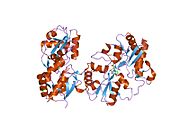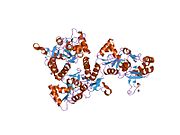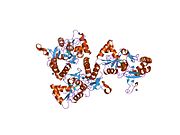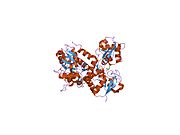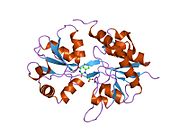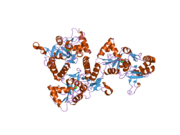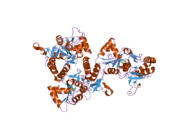| GRIA2 | |||||||||||||||||||||||||||||||||||||||||||||||||||
|---|---|---|---|---|---|---|---|---|---|---|---|---|---|---|---|---|---|---|---|---|---|---|---|---|---|---|---|---|---|---|---|---|---|---|---|---|---|---|---|---|---|---|---|---|---|---|---|---|---|---|---|
 | |||||||||||||||||||||||||||||||||||||||||||||||||||
| |||||||||||||||||||||||||||||||||||||||||||||||||||
| Identifiers | |||||||||||||||||||||||||||||||||||||||||||||||||||
| Aliases | GRIA2, GLUR2, GLURB, GluA2, GluR-K2, HBGR2, glutamate ionotropic receptor AMPA type subunit 2, gluR-B, gluR-2, NEDLIB | ||||||||||||||||||||||||||||||||||||||||||||||||||
| External IDs | OMIM: 138247; MGI: 95809; HomoloGene: 20225; GeneCards: GRIA2; OMA:GRIA2 - orthologs | ||||||||||||||||||||||||||||||||||||||||||||||||||
| |||||||||||||||||||||||||||||||||||||||||||||||||||
| |||||||||||||||||||||||||||||||||||||||||||||||||||
| |||||||||||||||||||||||||||||||||||||||||||||||||||
| |||||||||||||||||||||||||||||||||||||||||||||||||||
| Wikidata | |||||||||||||||||||||||||||||||||||||||||||||||||||
| |||||||||||||||||||||||||||||||||||||||||||||||||||
Glutamate ionotropic receptor AMPA type subunit 2 (Glutamate receptor 2, or GluR-2) is a protein that in humans is encoded by the GRIA2 (or GLUR2) gene and it is a subunit found in the AMPA receptors.
Function
Glutamate receptors are the predominant excitatory neurotransmitter receptors in the mammalian brain and are activated in a variety of normal neurophysiologic processes. This gene product belongs to a family of glutamate receptors that are sensitive to alpha-amino-3-hydroxy-5-methyl-4-isoxazole propionate (AMPA), called AMPA receptors, and function as ligand-activated cation channels. These channels are assembled from a combination of 4 subunits, encoded by 4 genes (GRIA1-4). The subunit encoded by this gene (GRIA2) is subject to RNA editing which renders the receptor that it becomes part of impermeable to calcium ions (Ca). Human and animal studies suggest that the RNA editing is essential for normal brain function, and defective RNA editing of this gene may be relevant to the etiology of amyotrophic lateral sclerosis (ALS). Alternative splicing, resulting in transcript variants encoding different isoforms, has been noted for this gene, which includes the generation of flip and flop isoforms that vary in their signal transduction properties.
Interactions
GRIA2 has been shown to interact with SPTAN1, GRIP1 and PICK1.
RNA editing
Several ion channels and neurotransmitters receptors pre-mRNA as substrates for ADARs. This includes 5 subunits of the glutamate receptor ionotropic AMPA glutamate receptor subunits (Glur2, Glur3, Glur4) and kainate receptor subunits (Glur5, Glur6). Glutamate-gated ion channels are made up of four subunits per channel, with each subunit contributing to the pore loop structure. The pore loop structure is related to that found in K channels (e.g., human Kv1.1 channel). The human Kv1.1 channel pre mRNA is also subject to A to I RNA editing. The function of the glutamate receptors is in the mediation of fast neurotransmission to the brain. The diversity of the subunits is determined, as well as RNA splicing by RNA editing events of the individual subunits. This give rise to the necessarily high diversity of these receptors. Glur2 is a gene product of the pre-mRNA of the GRIA2 gene and subject to RNA editing.
Type
The type of RNA editing that occurs in the pre-mRNA of GluR-2 is Adenosine-to-Inosine (A-to-I) editing. A-to-I RNA editing is catalyzed by a family of adenosine deaminases acting on RNA (ADARs) that specifically recognize adenosines within double-stranded regions of pre-mRNAs and deaminate them to inosine. Inosines are recognised as guanosine by the cells translational machinery. There are three members of the ADAR family ADARs 1-3, with ADAR1 and ADAR2 being the only enzymatically active members. ADAR3 is thought to have a regulatory role in the brain. ADAR1 and ADAR2 are widely expressed in tissues, while ADAR3 is restricted to the brain. The double-stranded regions of RNA are formed by base-pairing between residues in the close to region of the editing site, with residues usually in a neighboring intron, but can be an exonic sequence. The region that base pairs with the editing region is known as an Editing Complementary Sequence (ECS). ADARs bind interact directly with the dsRNA substrate via their double-stranded RNA binding domains. If an editing site occurs within a coding sequence, it can result in a codon change. This can lead to translation of a protein isoform due to a change in its primary protein structure. Therefore, editing can also alter protein function. A-to-I editing occurs in a non coding RNA sequences such as introns, untranslated regions (UTRs), LINEs, SINEs (especially Alu repeats). The function of A to I editing in these regions is thought to involve creation of splice sites and retention of RNAs in the nucleus amongst others.
Location
In the pre-mRNA of GluR-2 the editing site Q/R is found at amino acid position 607. This location is in the pore loop region deep within the ion channel in the proteins membrane segment 2. Editing results in a change from a glutamine(Q) codon to an Arginine (R) codon. Editing at the R/G site, located at amino acid position 764 results in a codon change from arginine to glycine. All editing in glutamate receptors occurs in double-stranded RNAs (dsRNAs), which form due to complementary base pairing between the region of the editing site within the exon and an ECS within an intron sequence. R/G site
Conservation
Regulation
Editing occurs at the Q/R site at a frequency of 100% of GluR2 transcripts in the brain. It is the only known editing site to be edited at a frequency of 100%. However some striatal and cortical neurons are edited less frequently. This has been suggested as a reason for the higher level of excitotoxicity of these particular neurons. The R/G site is developmentally regulated, being largely unedited in the embryonic brain with levels rising after birth. (ref 53)
Consequences
Structure
Editing results in a codon change from a glutamine codon (CAG) to an arginine codon (CIG). Editing at R/G results in a codon change. The region of the editing site is known to be the region that controls divalent cation permeability. The other ionotropic AMPA glutamate receptors have a genomically encoded have a glutamine residue, while GluR2 has an arginine.
Function
RNA editing of the GluR-2 (GluR-B) pre-mRNA is the best-characterised example of A-to-I editing. Activated by L-Glutamate, a major excitatory neurotransmitter in vertebrates central nervous systems, it acts as an agonist at NMDA, AMPA, and kainate neurotransmitters.(103) Activation results in neuronal cation entry (CA2+), causing membrane depolarisation required for the process of excitatory neurotransmission. The calcium permeability of these receptor channels is required for many important events in the CNS, including long-term potentiation.(104) Since editing occurs in nearly 100% of transcripts and is necessary for life, it is often wondered why edited GluR-B is not genomically encoded instead of being derived by RNA editing. The answer is unknown.
RNA editing at the Q/R site is thought to alter the permeability of the channel rendering it impermeable to Ca. The Q/R site also occurs in the Kainate receptors GluR5 and GluR6. Editing at the Q/R site determines the calcium permeability of the channel, with channels containing the edited form being less permeable to calcium. This differs from GluR6 where editing of the Q/R site may increase calcium permeability of the channel especially if the I/V and Y/C sites are also edited. Therefore, the main function of editing is therefore in regulation of electrophysiology of the channel.
Editing in some striatal and cortical neurons is more likely to be subject to excitotoxicity, thought to be due to less than 100% editing of these particular neurons. Editing also has several other function effects. Editing alters the maturation and assembly of the channel, with the unedited form having a tendency to tetramerize and then is transported to the synapse. However, the edited version is assembled as a monomer and resides mainly in the endoplasmic reticulum. The arginine residue in the pore loop of GluR-2 receptor is thought to belong to a retention signal for the endoplasmic reticulum. Therefore, editing - since it occurs at 100% frequency - inhibits the availability of the channel at the synapse. This process occurs before assembly of the channels, thereby preventing glur-2-forming homeric channels, which could interfere with synaptic signalling.
Editing also occurs at the R/G site. Editing at the R/G sites results in variation in the rate that the receptor recovers from desensitisation. Editing at these sites results in faster recovery time from desensitisation
Dysregulation
Amyotrophic Lateral Sclerosis
Many human and animal studies have determined that RNA editing of the Q/R site in GluR2 pre-mRNA is necessary for normal brain function. Defective editing has been linked to several conditions such as amyotrophic lateral sclerosis (ALS). ALS effects 1 in 2000 people, usually fatal in 1–5 years, with onset in the majority of cases being sporadic and minority being familial. With these conditions motor neurons degenerate leading to eventual paralysis and respiratory failure. Glutamate excitotoxicity is known to contribute to the spread of the sporadic condition. Glutamate levels are increased up 40%, suggesting that activation of glutamate receptors could be the reason for this causing increase Ca influx and then neuronal death. Since decrease nor loss of editing at Q/R site would lead to increase in calcium permeability. In diseased motor neurons editing levels of Glur 2 (62-100%) at this site was discovered to be reduced. Abnormal editing is thought to be specific for this condition, as editing levels have not been found to be decreased in spinal and bulbar muscular atrophy. Q/R editing is not the only mechanism involved, as editing occurs only in spinal motor neurons not in upper spinal neurons. Also, it is unknown whether editing dysregulation is involved in the initiation of the condition, or whether it occurs during pathogenesis.
Epilepsy
In mouse models, failure of editing leads to epileptic seizures and death within 3 weeks of birth. Why editing exists at this site instead of a genomically encoded arginine is unknown since nearly 100% of transcripts are edited.
Cancer
Decreased editing at the Q/R site is also found in some human brain tumors. Reduction of ADAR2 expression is thought to be associated with epileptic seizures in malignant glioma.
Use in diagnostic immunochemistry
GRIA2 is a diagnostic immunochemical marker for solitary fibrous tumour (SFT), distinguishing it from most mimics. Among other CD34-positive tumours, GRIA2 is also expressed in dermatofibrosarcoma protuberans (DFSP); however, clinical and histologic features aid in their distinction. GRIA2 shows a limited distribution in other soft tissue tumours.
See also
References
- ^ GRCh38: Ensembl release 89: ENSG00000120251 – Ensembl, May 2017
- ^ GRCm38: Ensembl release 89: ENSMUSG00000033981 – Ensembl, May 2017
- "Human PubMed Reference:". National Center for Biotechnology Information, U.S. National Library of Medicine.
- "Mouse PubMed Reference:". National Center for Biotechnology Information, U.S. National Library of Medicine.
- HGNC. "Symbol Report: GRIA2". Retrieved 29 December 2017.
- Sun W, Ferrer-Montiel AV, Schinder AF, McPherson JP, Evans GA, Montal M (Mar 1992). "Molecular cloning, chromosomal mapping, and functional expression of human brain glutamate receptors". Proc Natl Acad Sci U S A. 89 (4): 1443–7. Bibcode:1992PNAS...89.1443S. doi:10.1073/pnas.89.4.1443. PMC 48467. PMID 1311100.
- ^ "Entrez Gene: GRIA2 glutamate receptor, ionotropic, AMPA 2".
- Hideyama, Takuto; Kwak, Shin (2011). "When Does ALS Start? ADAR2-GluA2 Hypothesis for the Etiology of Sporadic ALS". Frontiers in Molecular Neuroscience. 4: 33. doi:10.3389/fnmol.2011.00033. ISSN 1662-5099. PMC 3214764. PMID 22102833.
- Hirai H, Matsuda S (September 1999). "Interaction of the C-terminal domain of delta glutamate receptor with spectrin in the dendritic spines of cultured Purkinje cells". Neurosci. Res. 34 (4): 281–7. doi:10.1016/S0168-0102(99)00061-9. PMID 10576550. S2CID 45794233.
- ^ Hirbec H, Perestenko O, Nishimune A, Meyer G, Nakanishi S, Henley JM, Dev KK (May 2002). "The PDZ proteins PICK1, GRIP, and syntenin bind multiple glutamate receptor subtypes. Analysis of PDZ binding motifs". J. Biol. Chem. 277 (18): 15221–4. doi:10.1074/jbc.C200112200. hdl:2262/89271. PMID 11891216.
- ^ Seeburg PH, Single F, Kuner T, Higuchi M, Sprengel R (July 2001). "Genetic manipulation of key determinants of ion flow in glutamate receptor channels in the mouse". Brain Res. 907 (1–2): 233–43. doi:10.1016/S0006-8993(01)02445-3. PMID 11430906. S2CID 11969068.
- Bhalla T, Rosenthal JJ, Holmgren M, Reenan R (October 2004). "Control of human potassium channel inactivation by editing of a small mRNA hairpin". Nat. Struct. Mol. Biol. 11 (10): 950–6. doi:10.1038/nsmb825. PMID 15361858. S2CID 34081059.
- Egebjerg J, Kukekov V, Heinemann SF (October 1994). "Intron sequence directs RNA editing of the glutamate receptor subunit GluR2 coding sequence". Proc. Natl. Acad. Sci. U.S.A. 91 (22): 10270–4. Bibcode:1994PNAS...9110270E. doi:10.1073/pnas.91.22.10270. PMC 45001. PMID 7937939.
- ^ Kim DY, Kim SH, Choi HB, Min C, Gwag BJ (June 2001). "High abundance of GluR1 mRNA and reduced Q/R editing of GluR2 mRNA in individual NADPH-diaphorase neurons". Mol. Cell. Neurosci. 17 (6): 1025–33. doi:10.1006/mcne.2001.0988. PMID 11414791. S2CID 15351461.
- Sommer B, Köhler M, Sprengel R, Seeburg PH (October 1991). "RNA editing in brain controls a determinant of ion flow in glutamate-gated channels". Cell. 67 (1): 11–9. doi:10.1016/0092-8674(91)90568-J. PMID 1717158. S2CID 22029384.
- Egebjerg J, Heinemann SF (January 1993). "Ca2+ permeability of unedited and edited versions of the kainate selective glutamate receptor GluR6". Proc. Natl. Acad. Sci. U.S.A. 90 (2): 755–9. Bibcode:1993PNAS...90..755E. doi:10.1073/pnas.90.2.755. PMC 45744. PMID 7678465.
- Greger IH, Khatri L, Ziff EB (May 2002). "RNA editing at arg607 controls AMPA receptor exit from the endoplasmic reticulum". Neuron. 34 (5): 759–72. doi:10.1016/S0896-6273(02)00693-1. PMID 12062022. S2CID 15936250.
- Cleveland DW, Rothstein JD (November 2001). "From Charcot to Lou Gehrig: deciphering selective motor neuron death in ALS". Nat. Rev. Neurosci. 2 (11): 806–19. doi:10.1038/35097565. PMID 11715057. S2CID 2050462.
- Spreux-Varoquaux O, Bensimon G, Lacomblez L, et al. (January 2002). "Glutamate levels in cerebrospinal fluid in amyotrophic lateral sclerosis: a reappraisal using a new HPLC method with coulometric detection in a large cohort of patients". J. Neurol. Sci. 193 (2): 73–8. doi:10.1016/S0022-510X(01)00661-X. PMID 11790386. S2CID 25556626.
- Kwak S, Kawahara Y (February 2005). "Deficient RNA editing of GluR2 and neuronal death in amyotropic lateral sclerosis". J. Mol. Med. 83 (2): 110–20. doi:10.1007/s00109-004-0599-z. PMID 15624111. S2CID 2255590.
- Kawahara Y, Ito K, Sun H, Aizawa H, Kanazawa I, Kwak S (February 2004). "Glutamate receptors: RNA editing and death of motor neurons". Nature. 427 (6977): 801. Bibcode:2004Natur.427..801K. doi:10.1038/427801a. PMID 14985749. S2CID 4310256.
- Kawahara Y, Kwak S, Sun H, et al. (May 2003). "Human spinal motoneurons express low relative abundance of GluR2 mRNA: an implication for excitotoxicity in ALS". J. Neurochem. 85 (3): 680–9. doi:10.1046/j.1471-4159.2003.01703.x. PMID 12694394. S2CID 5997020.
- ^ Kawahara Y, Kwak S (September 2005). "Excitotoxicity and ALS: what is unique about the AMPA receptors expressed on spinal motor neurons?". Amyotrophic Lateral Sclerosis. 6 (3): 131–44. doi:10.1080/14660820510037872. PMID 16183555. S2CID 6640926.
- Maas S, Patt S, Schrey M, Rich A (December 2001). "Underediting of glutamate receptor GluR-B mRNA in malignant gliomas". Proc. Natl. Acad. Sci. U.S.A. 98 (25): 14687–92. Bibcode:2001PNAS...9814687M. doi:10.1073/pnas.251531398. PMC 64742. PMID 11717408.
- Vivero, M; Doyle, L. A.; Fletcher, C. D.; Mertens, F; Hornick, J. L. (2014). "GRIA2 is a Novel Diagnostic Marker for Solitary Fibrous Tumour Identified through Gene Expression Profiling". Histopathology. 65 (1): 71–80. doi:10.1111/his.12377. PMID 24456377. S2CID 42812062.
Further reading
- Soundarapandian MM, Tu WH, Peng PL, et al. (2007). "AMPA receptor subunit GluR2 gates injurious signals in ischemic stroke". Mol. Neurobiol. 32 (2): 145–55. doi:10.1385/MN:32:2:145. PMID 16215279. S2CID 21618951.
- McNamara JO, Eubanks JH, McPherson JD, et al. (1992). "Chromosomal localization of human glutamate receptor genes". J. Neurosci. 12 (7): 2555–62. doi:10.1523/JNEUROSCI.12-07-02555.1992. PMC 6575855. PMID 1319477.
- Sommer B, Keinänen K, Verdoorn TA, et al. (1990). "Flip and flop: a cell-specific functional switch in glutamate-operated channels of the CNS". Science. 249 (4976): 1580–5. Bibcode:1990Sci...249.1580S. doi:10.1126/science.1699275. PMID 1699275.
- Sommer B, Köhler M, Sprengel R, Seeburg PH (1991). "RNA editing in brain controls a determinant of ion flow in glutamate-gated channels". Cell. 67 (1): 11–9. doi:10.1016/0092-8674(91)90568-J. PMID 1717158. S2CID 22029384.
- Paschen W, Hedreen JC, Ross CA (1994). "RNA editing of the glutamate receptor subunits GluR2 and GluR6 in human brain tissue". J. Neurochem. 63 (5): 1596–602. doi:10.1046/j.1471-4159.1994.63051596.x. PMID 7523595. S2CID 25226376.
- Köhler M, Kornau HC, Seeburg PH (1994). "The organization of the gene for the functionally dominant alpha-amino-3-hydroxy-5-methylisoxazole-4-propionic acid receptor subunit GluR-B". J. Biol. Chem. 269 (26): 17367–70. doi:10.1016/S0021-9258(17)32444-4. PMID 7545935.
- Eastwood SL, Burnet PW, Beckwith J, et al. (1994). "AMPA glutamate receptors and their flip and flop mRNAs in human hippocampus". NeuroReport. 5 (11): 1325–8. doi:10.1097/00001756-199406270-00007. PMID 7919190.
- Sun W, Ferrer-Montiel AV, Montal M (1994). "Primary structure and functional expression of the AMPA/kainate receptor subunit 2 from human brain". NeuroReport. 5 (4): 441–4. doi:10.1097/00001756-199401120-00018. PMID 8003671.
- Higuchi M, Single FN, Köhler M, et al. (1994). "RNA editing of AMPA receptor subunit GluR-B: a base-paired intron-exon structure determines position and efficiency". Cell. 75 (7): 1361–70. doi:10.1016/0092-8674(93)90622-W. PMID 8269514. S2CID 25420811.
- McLaughlin DP, Cheetham ME, Kerwin RW (1993). "Expression of alternatively-spliced glutamate receptors in human hippocampus". Eur. J. Pharmacol. 244 (1): 89–92. doi:10.1016/0922-4106(93)90062-E. PMID 8420792.
- Srivastava S, Osten P, Vilim FS, et al. (1998). "Novel anchorage of GluR2/3 to the postsynaptic density by the AMPA receptor-binding protein ABP". Neuron. 21 (3): 581–91. doi:10.1016/S0896-6273(00)80568-1. PMID 9768844. S2CID 14448034.
- Matsuda S, Mikawa S, Hirai H (1999). "Phosphorylation of serine-880 in GluR2 by protein kinase C prevents its C terminus from binding with glutamate receptor-interacting protein". J. Neurochem. 73 (4): 1765–8. doi:10.1046/j.1471-4159.1999.731765.x. PMID 10501226. S2CID 39402443.
- Hirai H, Matsuda S (2000). "Interaction of the C-terminal domain of delta glutamate receptor with spectrin in the dendritic spines of cultured Purkinje cells". Neurosci. Res. 34 (4): 281–7. doi:10.1016/S0168-0102(99)00061-9. PMID 10576550. S2CID 45794233.
- Aruscavage PJ, Bass BL (2000). "A phylogenetic analysis reveals an unusual sequence conservation within introns involved in RNA editing". RNA. 6 (2): 257–69. doi:10.1017/S1355838200991921. PMC 1369911. PMID 10688364.
- Osten P, Khatri L, Perez JL, et al. (2000). "Mutagenesis reveals a role for ABP/GRIP binding to GluR2 in synaptic surface accumulation of the AMPA receptor". Neuron. 27 (2): 313–25. doi:10.1016/S0896-6273(00)00039-8. PMID 10985351. S2CID 16213962.
- Chung HJ, Xia J, Scannevin RH, et al. (2001). "Phosphorylation of the AMPA receptor subunit GluR2 differentially regulates its interaction with PDZ domain-containing proteins". J. Neurosci. 20 (19): 7258–67. doi:10.1523/JNEUROSCI.20-19-07258.2000. PMC 6772789. PMID 11007883.
- Armstrong N, Gouaux E (2000). "Mechanisms for activation and antagonism of an AMPA-sensitive glutamate receptor: crystal structures of the GluR2 ligand binding core". Neuron. 28 (1): 165–81. doi:10.1016/S0896-6273(00)00094-5. PMID 11086992. S2CID 3128719.
- Krampfl K, Schlesinger F, Zörner A, et al. (2002). "Control of kinetic properties of GluR2 flop AMPA-type channels: impact of R/G nuclear editing". Eur. J. Neurosci. 15 (1): 51–62. doi:10.1046/j.0953-816x.2001.01841.x. PMID 11860506. S2CID 35601416.
- Hirbec H, Perestenko O, Nishimune A, et al. (2002). "The PDZ proteins PICK1, GRIP, and syntenin bind multiple glutamate receptor subtypes. Analysis of PDZ binding motifs". J. Biol. Chem. 277 (18): 15221–4. doi:10.1074/jbc.C200112200. hdl:2262/89271. PMID 11891216.
External links
- GRIA2+protein,+human at the U.S. National Library of Medicine Medical Subject Headings (MeSH)
- http://darned.ucc.ie
This article incorporates text from the United States National Library of Medicine, which is in the public domain.
| Ion channel, cell surface receptor: ligand-gated ion channels | |||||||||||
|---|---|---|---|---|---|---|---|---|---|---|---|
| Cys-loop receptors |
| ||||||||||
| Ionotropic glutamates |
| ||||||||||
| ATP-gated channels |
| ||||||||||


























